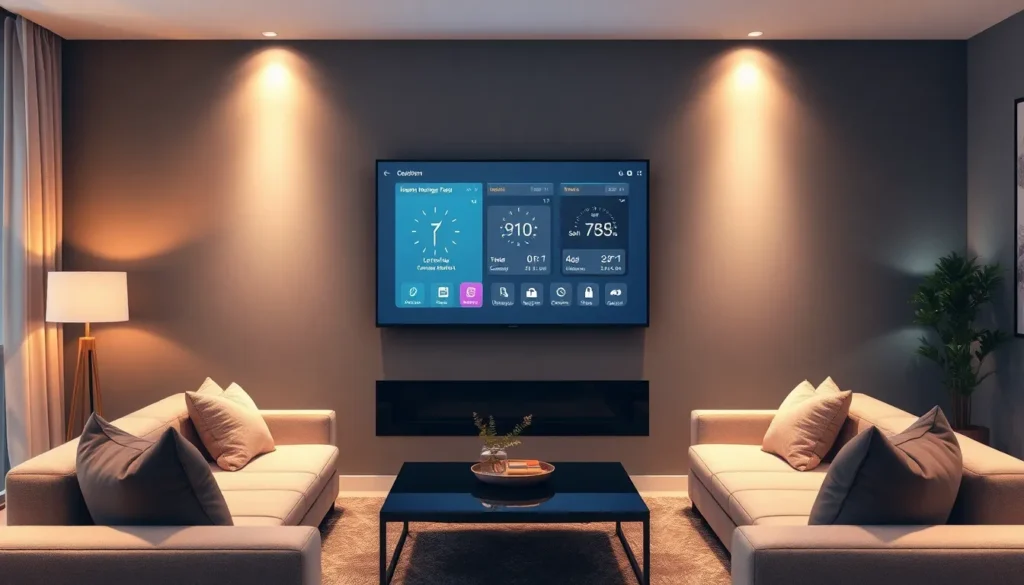Table of Contents
ToggleImagine walking into your home and having everything respond to your every whim. With smart panels, that dream can become a reality. These sleek, high-tech devices are revolutionizing the way people interact with their living spaces, turning ordinary homes into modern marvels.
Smart panels offer convenience, control, and a sprinkle of magic in everyday life. Whether it’s adjusting the thermostat with a simple tap or dimming the lights without getting off the couch, they make life feel like a scene from a sci-fi movie. Plus, who wouldn’t want to impress their friends with a home that practically runs itself?
Overview of Smart Panels for Homes
Smart panels for homes function as centralized control hubs that manage various smart devices within living spaces. These devices connect to numerous home systems, including lighting, heating, and security. Users benefit from a streamlined interface that simplifies interactions with technology.
Energy savings represent a significant advantage of smart panels. Statistics indicate that homes equipped with these devices can reduce energy consumption by up to 30 percent. Efficient energy management becomes achievable through programmable settings and real-time usage tracking.
Convenience plays a crucial role in the appeal of smart panels. Homeowners can access devices remotely via smartphone applications, enabling control from anywhere at any time. This feature enhances comfort, allowing adjustments without physical presence.
Integration with voice assistants is another key feature. Many smart panels support compatibility with systems like Amazon Alexa or Google Assistant, enhancing hands-free operation. Voice commands streamline tasks further and add to the overall ease of use.
The design of smart panels also caters to aesthetic preferences. Sleek, modern interfaces blend seamlessly with home decor while providing functionality. A variety of styles and configurations allows homeowners to choose options that complement their spaces.
Security features included with smart panels increase peace of mind. Enhanced surveillance and alert systems keep residents informed of any unusual activities. Notifications sent directly to smartphones ensure timely responses to potential concerns.
Benefits of Smart Panels

Smart panels provide multiple advantages that significantly impact home living. They enhance daily routines while promoting energy savings and increased control over various systems.
Improved Energy Efficiency
Energy bills see a noticeable decrease with smart panels. Homeowners can cut energy consumption by up to 30 percent through programmable settings. Devices utilize real-time tracking to identify energy usage patterns, encouraging more efficient habits. Smart panels allow users to schedule heating or cooling based on activity levels. Time-specific settings also optimize usage when homeowners are away, preventing unnecessary energy expenditure.
Enhanced Home Security
Smart panels contribute to improved home security through integrated surveillance systems. Residents can monitor security cameras directly from the central hub, offering real-time access to their property. Alerts notify homeowners of any suspicious activity, ensuring timely responses to potential threats. Many smart panels support connectivity with other security devices like motion detectors and smart locks. Comprehensive security solutions help create a safer living environment, enhancing peace of mind for all family members.
User Convenience and Control
Control over home devices becomes seamless with smart panels. Users operate lighting, heating, and security features from a single interface, reducing complexity. Remote access through smartphone applications means adjustments can occur from anywhere, making life easier. Voice command integration with assistants like Amazon Alexa or Google Assistant adds an additional layer of convenience. Personalized settings allow for tailored experiences that adapt to individual preferences and routines.
Types of Smart Panels
Smart panels come in various forms, each tailored to specific user needs and preferences. Three popular types of smart panels include touchscreen panels, voice-activated panels, and those with mobile app integration.
Touchscreen Panels
Touchscreen panels serve as intuitive control interfaces for smart devices. These panels display user-friendly graphics and allow easy navigation through various settings. Homeowners can adjust lighting, temperature, and security features with simple taps. Many touchscreen panels support multiple user accounts, providing personalized access for family members. Furthermore, advanced models often feature customizable dashboards, enabling users to prioritize their most-used functions.
Voice-Activated Panels
Voice-activated panels utilize built-in microphones to respond to spoken commands. Homeowners can control smart devices through voice instructions without the need for physical interaction. Integration with voice assistants like Alexa or Google Assistant enhances convenience. These panels enable users to set schedules, adjust settings, or query device status simply by speaking. Additionally, the hands-free operation supports accessibility for individuals with mobility challenges, making smart home technology inclusive.
Mobile App Integration
Mobile app integration connects smart panels to smartphones, granting control from anywhere. Homeowners can monitor and manage their devices while away from home. App functionality often includes real-time status updates, alerts, and notifications about device performance. Users can customize settings and even control devices remotely, ensuring flexibility and convenience. Many apps allow for automation of routines, such as adjusting thermostat settings or turning lights on or off based on user-defined schedules.
Installation and Setup
Installing smart panels can significantly enhance the functionality of a smart home. Homeowners have two main options for installation: professional services or do-it-yourself (DIY) efforts.
Professional Installation vs. DIY
Professional installation ensures that smart panels are set up correctly and integrated seamlessly with existing systems. Experts tackle any wiring or technical challenges, providing peace of mind. Hiring a professional might incur costs averaging between $100 and $300. Alternatively, homeowners comfortable with technology can choose the DIY route. This option typically requires researching installation instructions and ensuring compatibility with existing devices. DIY installations may save money upfront, but they often take more time and effort. Homeowners yield benefits from choosing an installation method that aligns with their skills and budget.
Compatibility with Smart Home Devices
Smart panels function as central control hubs, enhancing their value. Compatibility with various devices, such as smart lights, thermostats, and security systems, is crucial. Manufacturers usually provide lists of compatible devices, helping homeowners make informed choices. For example, many smart panels integrate seamlessly with devices from popular brands like Philips Hue and Nest. Homeowners can enhance the smart home experience by confirming compatibility before purchasing any device. Ensuring that devices work together optimizes performance and elevates convenience across the home.
Popular Brands and Models
Several brands excel in the smart panel market, each offering unique features to suit different needs. Amazon produces the Fire Tablet, which integrates seamlessly with Echo devices for a comprehensive smart home experience. Google offers the Nest Hub, designed with a user-friendly interface and extensive compatibility with various smart devices.
Samsung stands out with its SmartThings panel, connecting a wide range of products from home security to lighting. Ecobee presents the SmartThermostat, a model focused on energy efficiency and comfort. Lutron specializes in lighting control systems, providing users with options like the Lutron Caseta for efficient dimming and scheduling.
In the realm of DIY options, Wyze offers affordable, easy-to-install devices for budget-conscious homeowners. Apple has entered the smart panel segment with HomePod, integrating with HomeKit for an ecosystem tailored for Apple users. Honeywell brings innovation with its Home app, featuring a range of thermostats and security systems for comprehensive climate control and safety.
The functionality of these smart panels varies, with some models equipped with touchscreens for direct control. Others, such as voice-activated panels from Sonos, enable hands-free operation, enhancing convenience during busy moments. Remote access via mobile apps is a growing trend, allowing homeowners to monitor and adjust settings anywhere.
Pricing for these smart panels varies widely, typically ranging from $50 to $500 based on features and brand reputation. Ensure compatibility by checking specifications with existing smart home devices before making a purchase. Brands like Philips Hue and Nest integrate well with most panels, optimizing the overall smart home setup.
Smart panels are revolutionizing home living by offering unparalleled convenience and control. They serve as essential hubs that streamline the management of various smart devices, enhancing energy efficiency and security. With options like touchscreen interfaces and voice activation, these panels cater to diverse user needs.
Homeowners can enjoy the flexibility of remote access and automation, making everyday tasks more manageable. As technology continues to evolve, smart panels will undoubtedly play a crucial role in creating efficient and secure living environments. Investing in these devices not only elevates home aesthetics but also contributes to a smarter and more sustainable lifestyle.




